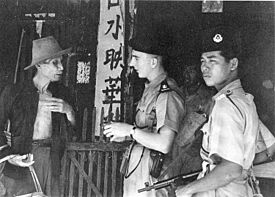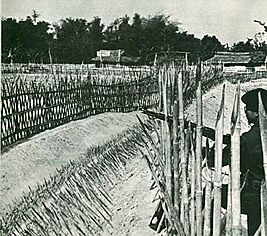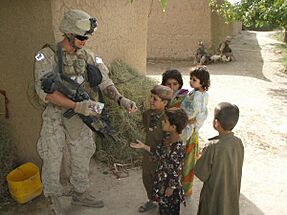Counterinsurgency facts for kids


Counterinsurgency (COIN, or NATO spelling counter-insurgency) is "the totality of actions aimed at defeating irregular forces". The Oxford English Dictionary defines counterinsurgency as any "military or political action taken against the activities of guerrillas or revolutionaries" and can be considered war by a state against a non-state adversary. Insurgency and counterinsurgency campaigns have been waged since ancient history. However, modern thinking on counterinsurgency was developed during decolonization.
During insurgency and counterinsurgency, the distinction between civilians and combatants is often blurred. Counterinsurgency may involve attempting to win the hearts and minds of populations supporting the insurgency. Alternatively, it may be waged in an attempt to intimidate or eliminate civilian populations suspected of loyalty to the insurgency through indiscriminate violence.
Contents
Models
Counterinsurgency is normally conducted as a combination of conventional military operations and other means, such as demoralization in the form of propaganda, Psy-ops, and assassinations. Counter-insurgency operations include many different facets: military, paramilitary, political, economic, psychological, and civic actions taken to defeat insurgency.
To understand counterinsurgency, one must understand insurgency to comprehend the dynamics of revolutionary warfare. Counter-insurgency focuses on bridging these gaps. Insurgents take advantage of social issues known as gaps. When the gaps are wide, they create a sea of discontent, creating the environment in which the insurgent can operate.
In The Insurgent Archipelago, John Mackinlay puts forward the concept of an evolution of the insurgency from the Maoist paradigm of the golden age of insurgency to the global insurgency of the start of the 21st century. He defines this distinction as "Maoist" and "post-Maoist" insurgency.
Tactics
"Drain the sea" tactic
With regard to tactics, the terms "drain the sea" or "drain the water" involves the forced relocation or elimination of the civilian population ("water") to expose the rebels or insurgents ("fish"). In other words, relocation deprives the aforementioned of the support, cover, and resources of the local population. This is typically targeted in that it specifically targets the demographic that supports the insurgency in a limited area where insurgency is taking place, but is indiscriminate from an individual perspective. Examples of use of this technique in counterinsurgency include Bar Kokhba revolt, Second Anglo-Boer War, Greek Civil War, General Order No. 11 (1863) in the American Civil War, Rohingya conflict, and Xinjiang conflict.
"Draining the sea" can also be accomplished through genocide by killing the population blamed for the insurgency. During World War II, Nazi Germany's counterinsurgency (Bandenbekämpfung, lit. bandit fighting) became intertwined with the Final Solution. Indiscriminate violence also has a deterrent effect.
A downside of such methods of counterinsurgency is their severity may provoke increased resistance from the targeted population. In contemporary times, concerns about public opinion and international law can rule out counterinsurgency campaigns using indiscriminate violence.
Assassination of leaders
Assassination of leaders can be a successful counterinsurgency tactic.
Oil spot

The oil spot approach is the concentration of counterinsurgent forces into an expanding, secured zone. The origins of the expression is to be found in its initial use by Marshal Hubert Lyautey, the main theoretician of French colonial warfare and counterinsurgency strategy. The oil spot approach was later one of the justifications given in the Pentagon Papers for the Strategic Hamlet Program.
Cordon and search
Cordon and search is a military tactic, one of the basic counterinsurgency operations in which an area is cordoned off and premises are searched for weapons or insurgents. Other related operations are "Cordon and knock" and "Cordon and kick". "Cordon and search" is part of a new doctrine called Stability and Support Operations or SASO. It is a technique used where there is no hard intelligence of weapons in the house and therefore is less intense than a normal house search. It is used in urban neighborhoods. The purpose of the mission is to search a house with as little inconvenience to the resident family as possible.
Air operations
Air power can play an important role in counterinsurgency, capable of carrying out a wide range of operations:
- Transportation in support of combatants and civilians alike, including casualty evacuations;
- Intelligence gathering, surveillance, and reconnaissance;
- Psychological operations, through leaflet drops, loudspeakers, and radio broadcasts;
- Air-to-ground attack against 'soft' targets.

Public diplomacy
In General David Petraeus' Counterinsurgency Field Manual, one of the many tactics described to help win in counterinsurgency warfare involves the use of public diplomacy through military means. Counterinsurgency is effective when it is integrated "into a comprehensive strategy employing all instruments of national power," including public diplomacy. The goal of COIN operations is to render the insurgents as ineffective and non-influential, by having strong and secure relations with the population of the host nation.
An understanding of the host nation and the environment that the COIN operations will take place in is essential. Public diplomacy in COIN warfare is only effective when there is a clear understanding of the culture and population at hand. One of the largest factors needed for defeating an insurgency involves understanding the populace, how they interact with the insurgents, how they interact with non-government organizations in the area, and how they view the counterinsurgency operations themselves.
Ethics is a common public diplomacy aspect that is emphasized in COIN warfare. Insurgents win their war by attacking internal will and the international opposition. To combat these tactics, the counterinsurgency operations need to treat their prisoners and detainees humanely and according to American values and principles. By doing this, COIN operations show the host nation's population that they can be trusted and that they are concerned about the well-being of the population to be successful in warfare.

A population that expects the incumbent government to deliver public goods, services, and security frequently supports the counterinsurgency, and a major event that increases popular expectations of future public goods and service delivery can trigger a shift in public attitudes away from the insurgency and toward the counterinsurgency. "Political, social, and economic programs are usually more valuable than conventional military operations in addressing the root causes of the conflict and undermining the insurgency." These programs are essential in order to gain the support of the population. These programs are designed to make the local population feel secure, safe, and more aligned with the counterinsurgency efforts; this enables the citizens of the host nation to trust the goals and purposes of the counterinsurgency efforts, as opposed to the insurgents'. A counterinsurgency is a battle of ideas and the implementation and integration of these programs is important for success. Social, political and economic programs should be coordinated and administered by the host nation's leaders, as well. Successful COIN warfare allows the population to see that the counterinsurgency efforts are including the host nation in their re-building programs. The war is fought among the people and for the people between the insurgents and the counterinsurgents.
A counterinsurgency is won by utilizing strategic communications and information operations successfully. A counterinsurgency is a competition of ideas, ideologies, and socio-political movements. In order to combat insurgent ideologies one must understand the values and characteristics of the ideology or religion. Additionally, counterinsurgency efforts need to understand the culture of which the insurgency resides, in order to strategically launch information and communication operations against the insurgent ideology or religion. Counterinsurgency information operatives need to also identify key audiences, communicators, and public leaders to know whom to influence and reach out to with their information.
Information operations
Public diplomacy in information operations can only be achieved by a complete understanding of the culture it is operating in. Counterinsurgency operations must be able to perceive the world from the locals' perspective. To develop a comprehensive cultural picture counterinsurgency efforts should invest in employing "media consultants, finance and business experts, psychologists, organizational network analysts, and scholars from a wide range of disciplines." Most importantly, counterinsurgency efforts need to be able to understand why the local population is drawn into the insurgent ideology, like what aspects are appealing and how insurgents use the information to draw their followers into the ideology. Counterinsurgency communication efforts need a baseline understanding of values, attitudes, and perceptions of the people in the area of operations to conduct successful public diplomacy to defeat the enemy.
Developing information and communication strategies involve providing a legitimate alternate ideology, improving security and economic opportunity, and strengthening family ties outside of the insurgency. In order to conduct public diplomacy through these means, counterinsurgency communication needs to match its deeds with its words. Information provided through public diplomacy during a counterinsurgency cannot lie, the information and communication to the people always have to be truthful and trustworthy in order to be effective at countering the insurgents. Public diplomacy in counterinsurgency to influence the public thoughts and ideas is a long time engagement and should not be done through negative campaigning about the enemy.
Conducting public diplomacy through relaying information and communicating with the public in a counterinsurgency is most successful when a conversation can happen between the counterinsurgency team and the local population of the area of operation. Building rapport with the public involves "listening, paying attention, and being responsive and proactive" which is sufficient for the local population to understand and trust the counterinsurgency efforts and vice versa. This relationship is stringent upon the counterinsurgents keeping their promises, providing security to the locals, and communicating their message directly and quickly in times of need.
Understanding and influencing the cognitive dimension of the local population is essential to winning counterinsurgency warfare. The people's perception of legitimacy about the host nation and the foreign country's counterinsurgency efforts is where success is determined. "The free flow of information present in all theaters via television, telephone, and Internet, can present conflicting messages and quickly defeat the intended effects." Coordination between the counterinsurgency operations, the host nation, and the local media in the information presented to the public is essential to showing and influencing how the local population perceives the counterinsurgency efforts and the host nation.
Public opinion, the media, and rumors influence how the people view counterinsurgency, the government hosting their efforts, and the host nation legitimacy. The use of public diplomacy to strategically relay the correct messages and information to the public is essential to success in a counterinsurgency operation. For example, close relationships with media members in the area is essential to ensure that the locals understand the counterinsurgency objectives and feel secure with the host nation government and the counterinsurgency efforts. If the local media is not in sync with the counterinsurgency operatives then they could spread incomplete or false information about the counterinsurgency campaign to the public.
"Given Al Qaeda's global reach, the United States must develop a more integrated strategic communication strategy for counter-insurgency with its allies to diminish violent rhetoric, improve its image abroad, and detect, deter, and defeat this social movement at its many levels." Information operations and communicative abilities are one of the largest and most influential aspects of public diplomacy within a counterinsurgency.
Public diplomacy is especially important as modern insurgents are more easily able to gain support through a variety of sources, both local and transnational, thanks to advances in increased communication and globalization. Consequently, modern counter-insurgency requires attention to be focused on an insurgency's ecosystem from the national to the local level, in order to deprive the insurgency of support and prevent future insurgent groups from forming.
See also
General:
- Civilian casualty ratio
- Collective punishment
- Death squad
- Divide and rule
- Eizenstat and closing gaps
- False flag
- Foreign internal defence
- Fourth generation warfare
- Gladio
- Guerrilla warfare
- Grey-zone (international relations)
- Human rights violations
- Internally displaced people
- Irregular Warfare
- Kilcullen's Pillars
- Logical line of operation
- Low intensity conflict
- Counter-IED efforts
- COIN (board game)
Specific:
- Anti-partisan operations in World War II
- Bandenbekämpfung
- Clear and hold
- Counter Insurgency Force
- Counter-insurgency operations during the Second Chechen War
- Pacification of Manchukuo
- Strategic Hamlet
- Fireforce
U.S. specific:
- SEAL Team Six
- Special Forces
- Special Activities Division
- Delta Force
- 24th Special Tactics Squadron
- COINTELPRO
Police adaptations:
- C3 policing


